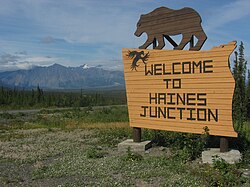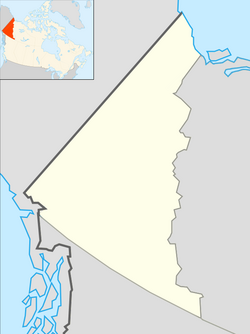Top Qs
Timeline
Chat
Perspective
Haines Junction
Village in Yukon, Canada From Wikipedia, the free encyclopedia
Remove ads
Haines Junction is a village in Yukon, Canada. It is at Kilometre 1,632 (historical mile 1016) of the Alaska Highway at its junction with the Haines Highway, hence the name of the community. According to the 2021 census, the population was 688.[4] However, the Yukon Bureau of Statistics lists the population count for 2022 as 1,018.[5]
Haines Junction lies east of Kluane National Park and Reserve. It is a major administrative centre for the Champagne and Aishihik First Nations.
Remove ads
History
Summarize
Perspective

For around two thousand years, the Southern Tutchone people had seasonal hunting and fishing camps in the area of present-day Haines Junction. The original name of the area was "Dakwakada", a Southern Tutchone word meaning "high cache". It was common for Tutchone people to use raised log caches to store food year-round or temporarily while they hunted and fished in an area.
The Haines Junction area was also important for trade between the coastal and interior peoples. It lies at the interior end of the Chilkat Pass, one of only three passes that allowed travel between the coast and the interior, which was used extensively for trade between the coastal Tlingit and Southern Tutchone people.
The current town of Haines Junction was established in 1942 and 1943 during the construction of the Alaska Highway (ALCAN). In 1943, a second highway, the Haines Highway, was built to connect the Alaska Highway with the coastal town of Haines, Alaska, over the Chilkat Pass. Situated at the junction of these two highways, Haines Junction was a construction camp and a supply and service centre for the United States Army Corps of Engineers building the highway. The 1,007 km (626 mi) Haines-Fairbanks Pipeline, a petroleum pipeline from Haines, Alaska to Fairbanks, Alaska that was constructed in 1953–55, with a pumping station was built just north of Haines Junction.[6]
Remove ads
Geography
Summarize
Perspective
Climate
Haines Junction has a subarctic climate (Dfc / Dsc) with mild summers and long, cold and snowy winters, with annual snowfall averaging 159.8 cm (62.9 in).[7]
Remove ads
Demographics
Summarize
Perspective
In the 2021 Canadian census conducted by Statistics Canada, Haines Junction had a population of 688 living in 311 of its 380 total private dwellings, a change of 12.2% from its 2016 population of 613. With a land area of 34.3 km2 (13.2 sq mi), it had a population density of 20.1/km2 (52.0/sq mi) in 2021.[4]
Remove ads
Infrastructure

By road, Haines Junction is served by the Alaska Highway and the Haines Highway (Yukon Highway 3). By air, it is served by the Haines Junction Airport.
Fibre connections to most homes and businesses are becoming available in late 2022 / early 2023. Bell Mobility operates a cellular network tower in the area.
See also
Notes
Remove ads
References
External links
Wikiwand - on
Seamless Wikipedia browsing. On steroids.
Remove ads



